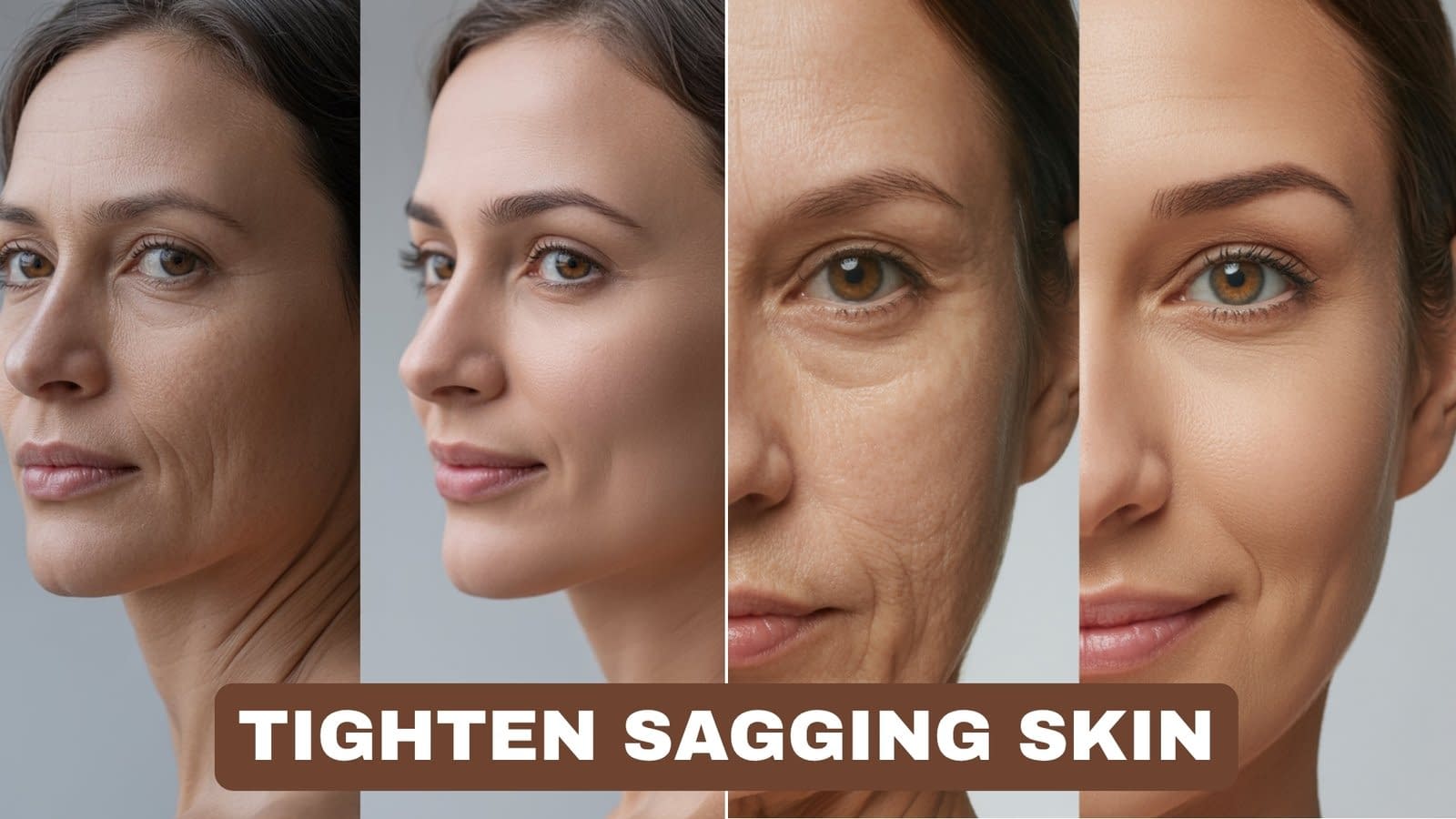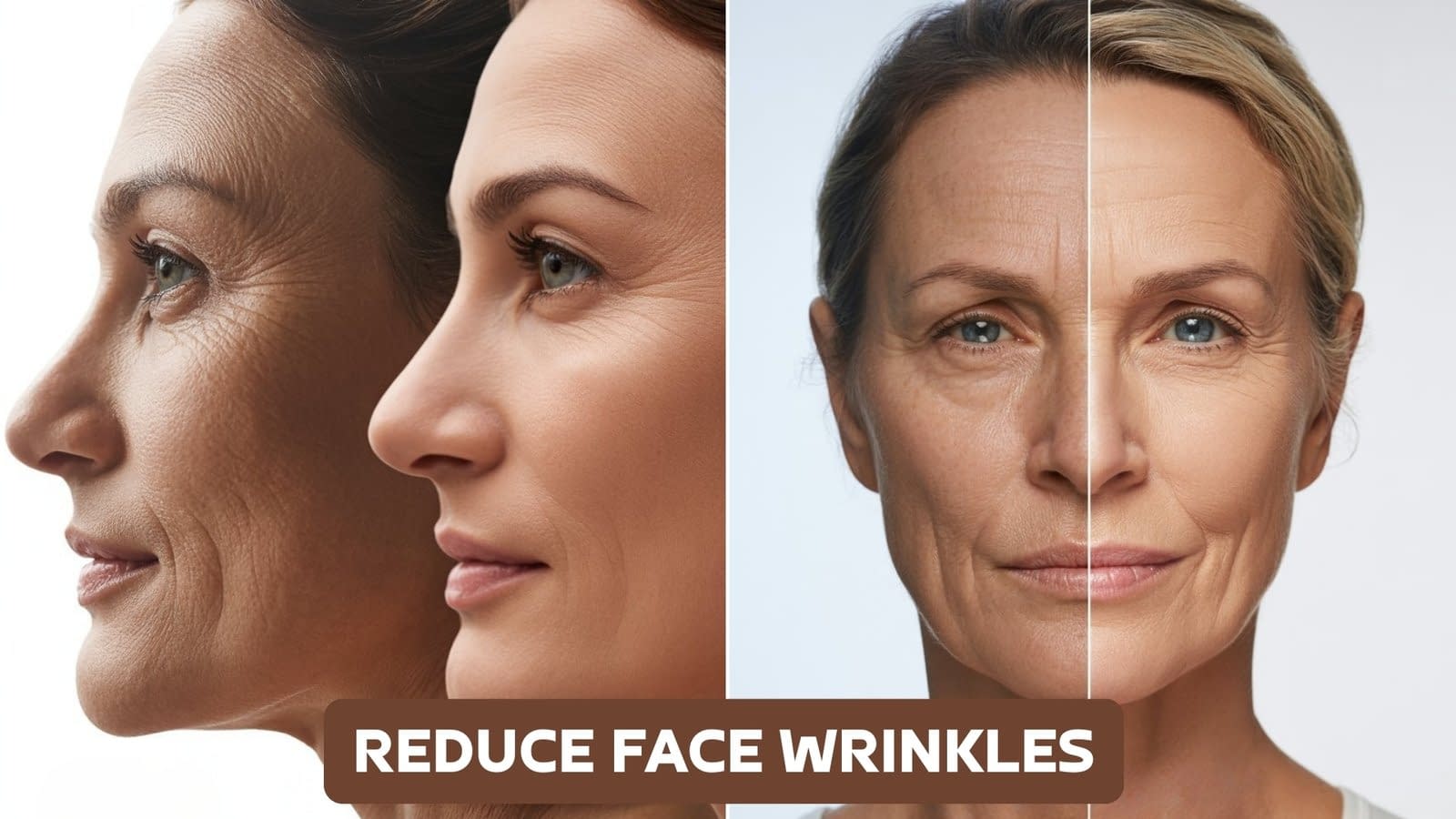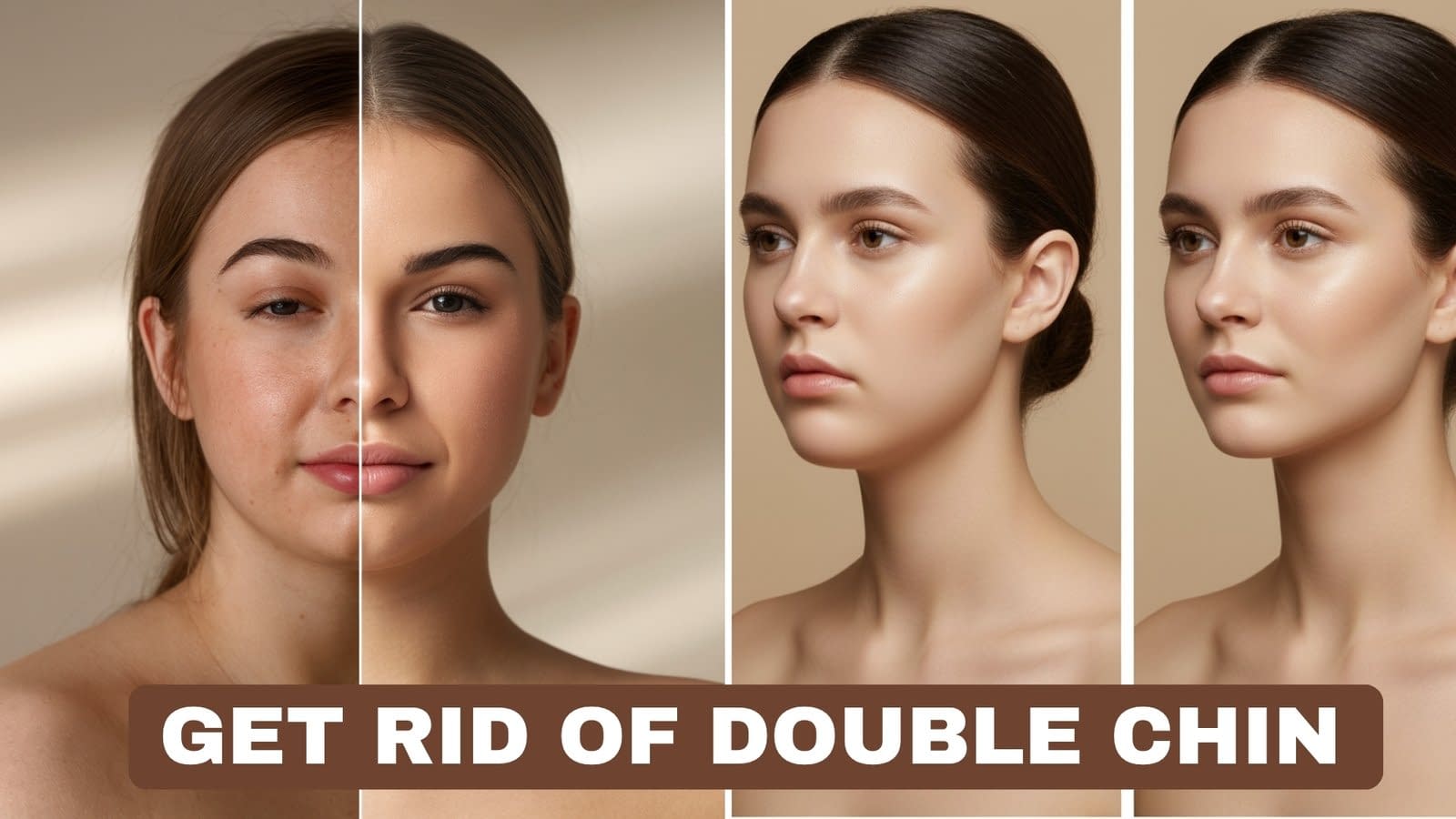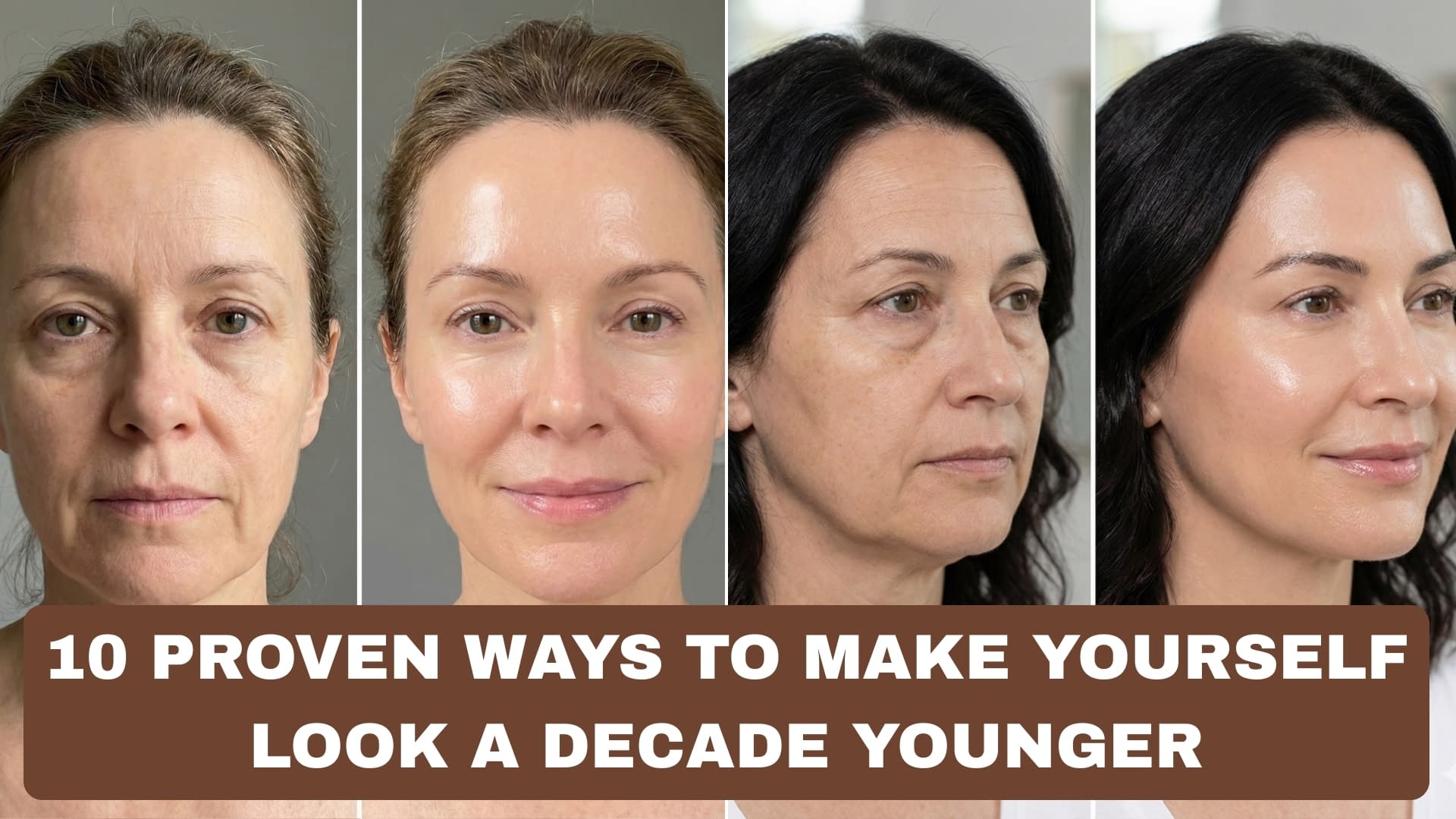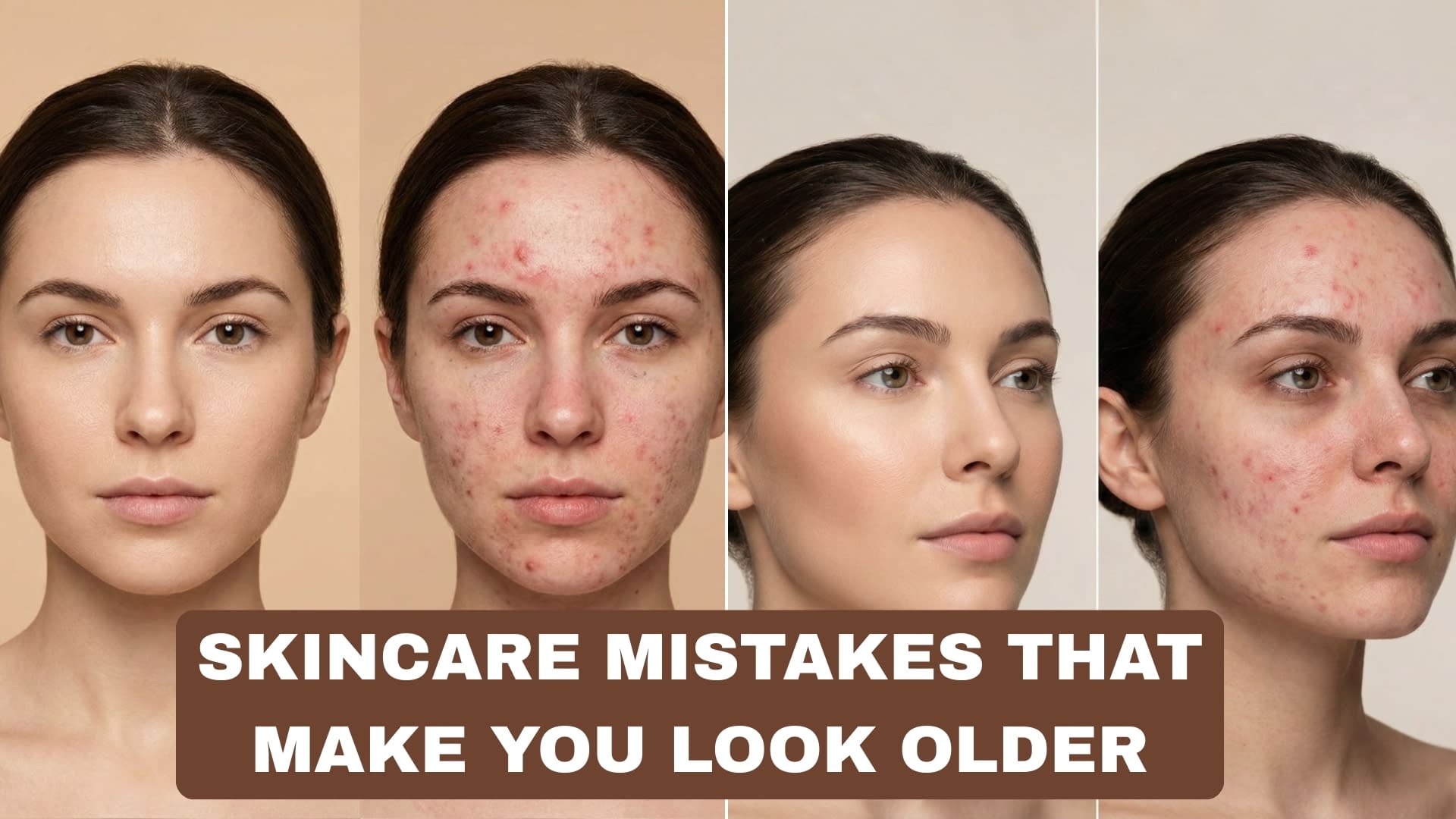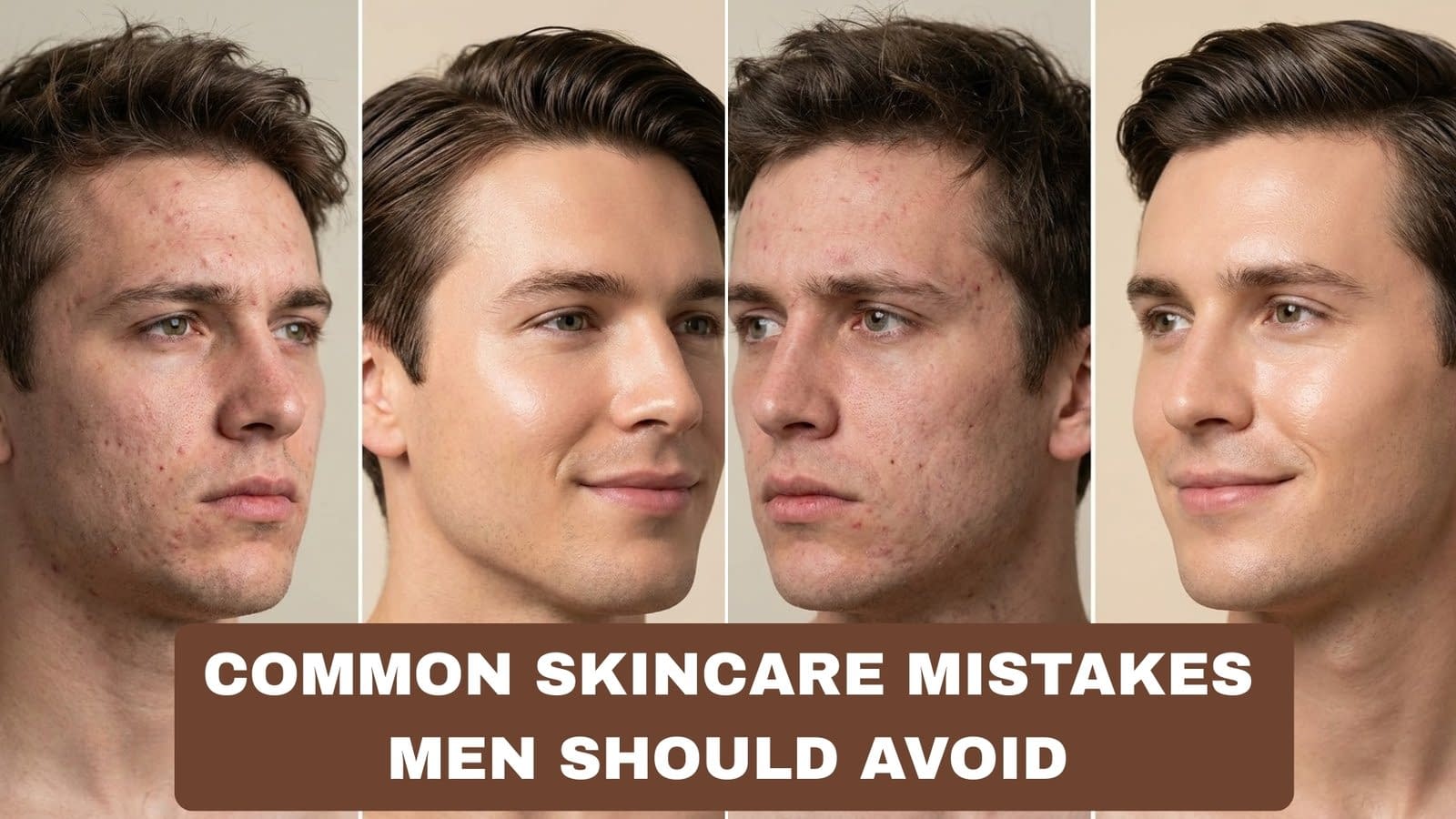Practical, science-friendly steps you can do at home — without buying a miracle cream or a tiny vibrating wand that costs more than your rent.
If your jawline used to be a defined thing and now it’s more “soft suggestion,” that’s normal. Skin sags because the structural support under it — collagen, elastin, fat compartments, and even bone — changes with age and lifestyle. You can’t rewind everything, but you can definitely improve tone, reduce visible sag, and slow further decline. Below is a realistic plan: what actually helps, what’s mostly marketing, step-by-step routines you can do at home, nutrition and lifestyle changes that matter, and a clear signpost for when to see a pro.
Why Skin Starts to Sag: The Real Culprits Behind Loose Skin
Short version: gravity helps, but biology does most of the work.
What’s happening, step-by-step:
- Collagen and elastin break down. These proteins hold skin firm. With age, production slows and existing fibers fragment.
- Support tissue changes. The fat pads under the skin change position and volume. Some areas lose volume (cheeks), others bulge (jowls), and that mix reshapes the face.
- Bone resorption. Facial bone density decreases slightly, especially the jaw and cheek bones, which reduces structural support.
- Loss of skin thickness and hydration. Thinner skin shows the changes more; dehydration makes sagging more obvious.
- External damage accelerates it. UV exposure, smoking, poor sleep, and repetitive heavy facial movements speed degradation of collagen and elastin.
- Genetics and hormones set the baseline: some people sag later, some earlier.
What this means for you: fixes must be twofold — rebuild/boost what you can (collagen, elasticity, volume support) and stop the things that keep tearing it down.
Can You Really Tighten Skin Naturally? What to Expect
Be honest: “tighten naturally” rarely equals surgical results. But you can improve firmness, texture, and the appearance of slackness — noticeably — with consistent effort.
Realistic outcomes:
- Short term (days–weeks): skin looks firmer when hydrated, de-puffed, and after massage. Temporary tightening from cooling or firming serums is visible but short-lived.
- Medium term (8–12 weeks): with retinoids, vitamin C, peptides, and sun protection you’ll see improved texture, reduced fine lines, and better skin tone. Some collagen rebuilding happens.
- Long term (months): regular facial exercise, massage, consistent topical actives, and lifestyle changes can noticeably lift and firm; still, not the same as a surgical lift or medical energy-device result.
- If structural support is gone (significant bone resorption or large fat descent): non-surgical devices or surgery may be the only way to achieve big, lasting tightening.
Bottom line: set expectations — you can improve and maintain, but you probably won’t reverse a deep jowl into a 25-year-old jawline without professional procedures.
Face-Firming Home Remedies That Actually Work
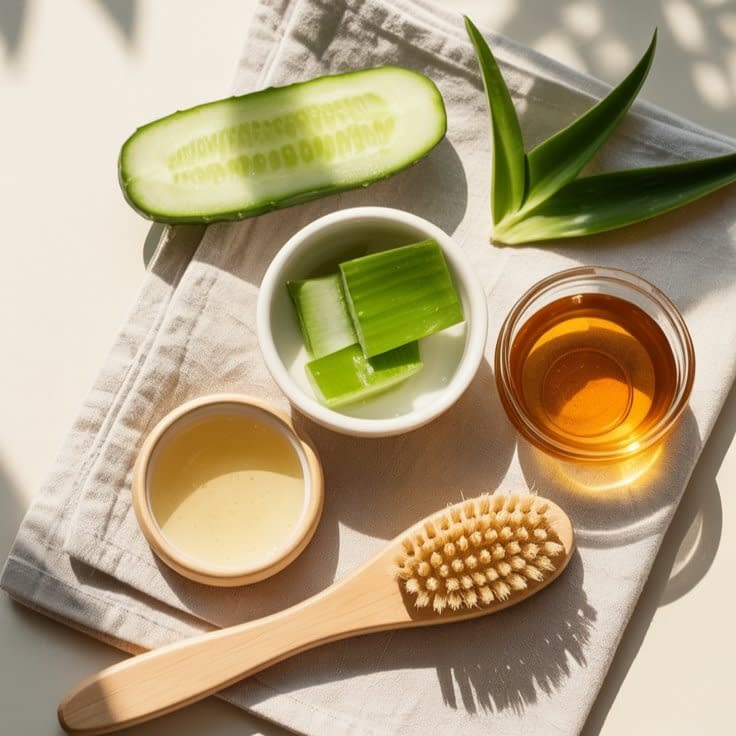
Home remedies that are meaningful combine actives that stimulate collagen, physical stimulation (massage/exercise), and barrier support.
Daily routine (step-by-step):
- Morning — antioxidant + sunscreen
- Cleanse gently.
- Apply a vitamin C serum (L-ascorbic acid 10–20% or stable form like MAP) to protect from oxidative stress and help collagen formation. Let it absorb.
- Moisturize with ceramide/niacinamide product to support barrier.
- Apply broad-spectrum SPF 30+ (mineral or chemical depending on tolerance). Reapply if you’re outdoors.
- Evening — repair & stimulate
- Cleanse gently.
- Use a retinoid (retinol, retinaldehyde, or prescription tretinoin) 2–4 nights/week to start, then increase as tolerated. Retinoids are among the best topical options for boosting collagen and improving laxity over months.
- On alternate nights use a peptide serum (matrixyl, copper peptides) to support collagen and elastin production. Peptides are gentler and support long-term remodeling.
- Seal with a hydrating moisturizer (hyaluronic acid → cream with ceramides and fatty acids).
- Weekly
- Add one gentle chemical exfoliation (lactic acid 5–10% or low-strength glycolic 5–8%) to speed cell turnover — do not over-exfoliate.
- Optionally use a firming mask (clay + hydrating glycerin) to temporarily tighten and visually lift skin.
Topical ingredient priority list:
- Retinoids (long-term rebuild)
- Vitamin C in AM (antioxidant + collagen support)
- Peptides (support remodeling)
- Niacinamide (barrier + texture)
- Hyaluronic acid (hydration, plumpness)
Practical tips:
- Start one active at a time to monitor irritation.
- Always use sunscreen with retinoids and acids.
- If irritation occurs, reduce frequency and boost barrier with ceramides and emollients.
Neck Tightening Tricks You Shouldn’t Ignore
Neck skin is different — thinner, with different movements — so it needs targeted care.
Neck routine (step-by-step):
- Daily protection: extend your sunscreen and vitamin C down to the neck and chest every morning. These areas get sun too.
- Neck-specific moisturization: apply a slightly richer cream at night (ceramides + peptides) to the neck; pat don’t rub.
- Neck massage & exercises (daily, 3–5 minutes): see section 7 for technique — they help lymph drainage and tone the platysma muscle which supports the neck.
- Retinoid use: introduce retinoids cautiously on the neck (skin is thin). Start once or twice weekly and observe for irritation — if tolerated, you can increase frequency.
- Physical support: good posture reduces constant downward pulling. Keep chin elevated occasionally; don’t stare down at your phone all day.
- Passive support: wearing a silk scarf when out helps reduce acute sun and wind damage.
Neck exercises to try (2 minutes, twice daily)
- Chin lifts: tilt head back, pucker lips as if kissing the ceiling, hold 5 sec, repeat 10–15x.
- Platysma stretch: pull lower jaw down and out, feel the vertical bands, hold 5 sec, repeat 10x.
- Neck resistance: press palm against forehead and push head forward into it (isometric), hold 5 sec, repeat 8–10x; do similar pushing against each side.
These won’t eliminate loose skin but improve muscle support and appearance.
Everyday Habits That Make Sagging Worse (and How to Stop Them)
Stop wrecking progress. Small habits matter more than snake-oil creams.
Habits to ditch and what to do instead
- Sun exposure without protection: the single worst habit. Use SPF daily, hats, and shade.
- Smoking: stops collagen production and accelerates sagging — quitting helps, and it helps fast.
- Poor sleep posture: sleeping face-down or on the side increases mechanical creep. Sleep on your back if possible and use a silk pillowcase to reduce friction.
- Sugar and high glycemic foods: glycation stiffens collagen, making it brittle. Reduce sugar and refined carbs.
- Chronic dehydration and low protein: skin needs water and amino acids to repair — drink consistently and eat adequate protein.
- Phone posture (“tech neck”): hold the phone at eye level, not on your lap; strengthen neck muscles with exercises.
- Over-aggressive skincare: over-exfoliation strips barrier and reduces tolerance to powerful actives. Gentle consistency wins.
Practical behavior checklist (daily)
- Apply SPF every morning and reapply outdoors.
- No smoking; reduce alcohol.
- Sleep on your back or use a silk pillowcase.
- Eat balanced meals with protein and colorful vegetables.
- Keep phone at eye level and take short posture breaks every 30–45 minutes.
Foods That Help Boost Collagen and Elasticity

Nutrition isn’t magic, but it’s a multiplier — do the topical work and feed the system.
Eat to support skin (specifics + serving ideas)
- Protein & amino acids: collagen synthesis needs building blocks — eat fish, chicken, eggs, legumes, tofu. Consider collagen peptides (10–15 g/day) if you like; some studies show small benefit for skin elasticity.
- Vitamin C: essential for collagen crosslinking — citrus, strawberries, bell peppers, dark leafy greens. Aim for one vitamin C–rich item per day.
- Zinc & copper: mineral cofactors for collagen synthesis — oysters, pumpkin seeds, nuts, whole grains, liver (or supplements if deficient).
- Omega-3 fats: reduce inflammation and support skin barrier — salmon, mackerel, walnuts, chia. Aim for 1–2 servings of fatty fish per week or a daily plant source.
- Polyphenols & antioxidants: green tea, berries, dark chocolate (in moderation) help protect from oxidative damage.
- Hydration & electrolytes: sip water through the day; include hydrating foods (cucumber, melon).
Sample daily plan
- Breakfast: Greek yogurt + berries + a sprinkle of seeds.
- Lunch: grilled salmon salad with spinach, bell pepper, lemon dressing.
- Snack: orange or handful of nuts.
- Dinner: chicken or tofu stir-fry with colorful veg.
- Option: 10–15 g collagen peptides stirred into morning coffee or a smoothie.
Massage Techniques to Lift and Tone Your Face and Neck
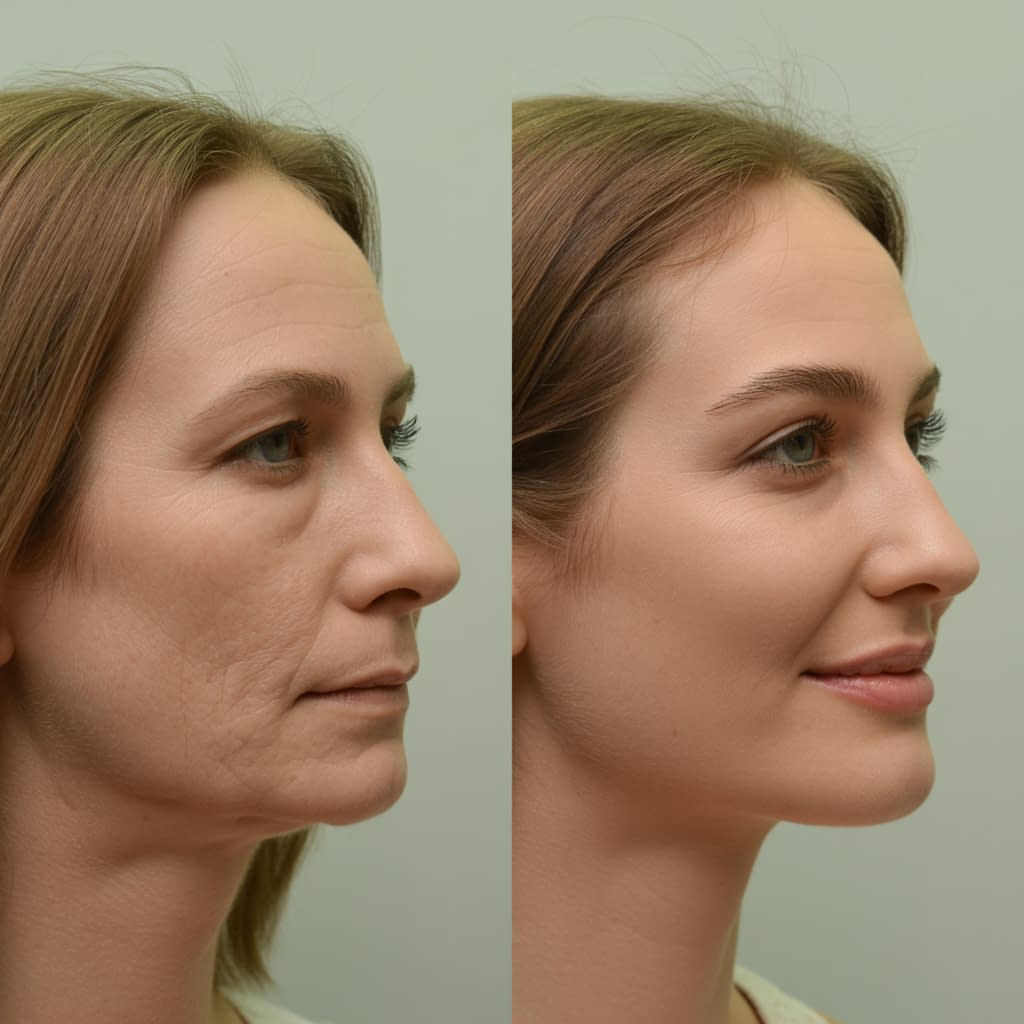
Massage isn’t babble — it increases circulation, moves fluid, stimulates fibroblasts, and helps product penetration. Do it daily and be consistent.
Daily 5-minute face & neck massage (step-by-step)
- Prep: apply a lightweight oil or serum (jojoba, squalane, or a dedicated face oil) to reduce friction. Use ring fingers for delicate pressure on the face.
- Neck drain: start at the neck base. Using both hands, sweep from the center of the neck out toward the collarbone with light pressure 6–8x to encourage lymphatic drainage.
- Jawline sweep: place thumbs under chin and use index/middle fingers to sweep from chin along jawline toward the ear 6–8x on each side. This lifts and helps move fluid.
- Cheek lift: using both palms, sweep from corners of mouth upward to cheekbones, finishing at temples. Repeat 8–10x.
- Brow & forehead: use circular motions from center out, then swipe outward to hairline to relieve tension that can drag skin down. Repeat 6–8x.
- Platysma massage (neck band): place fingers under chin and move downward along the neck in outward strokes; repeat 8–10x.
- Finish: gentle tapping across cheekbones to stimulate circulation (30–45 seconds).
Weekly 10–15 minute deep session
- Add gua sha or a jade roller after oil application: sweep from midline to hairline in long strokes; hold at problematic spots for 10–20 seconds, then move on. Gua sha can produce immediate lifting look by moving fluid and stimulating microcirculation.
Safety & tips
- Always move toward lymph nodes (downward on neck, outward on face).
- Don’t massage over active acne, open wounds, or infected cysts.
- Pressure should be firm but comfortable — not painful.
- If using tools (gua sha), learn proper angles to avoid bruising.
Best Natural Oils and Ingredients for Firmer Skin
Oils can’t rebuild collagen by themselves, but they improve barrier function, reduce TEWL, and provide vehicle for massage.
Top oils & how to use them
- Rosehip oil: contains provitamin A and linoleic acid; good for texture, pigmentation, and skin health. Use at night under moisturizer.
- Argan oil: rich in fatty acids and vitamin E; moisturizing and non-greasy. Good for daily hydration.
- Jojoba oil: mimics sebum, great as a lightweight massage oil or carrier.
- Squalane (plant): stable, non-comedogenic, excellent for moisturizer layering.
- Bakuchiol: plant alternative to retinol with fewer irritations; may support firmness—use if retinoids irritate you.
- Centella asiatica (cica): has peptides and triterpenes that support collagen and soothe skin — use in serums or creams.
- Green tea extract / polyphenols: protective antioxidant when used topically.
How to apply (simple ritual)
- After cleansing, put 2–3 drops of oil in your palms, warm it, and apply in upward strokes.
- Do the 5-minute massage sequence while the oil is on.
- Finish with a moisturizer to seal. Use oils nightly or a few times a week as a massage vehicle.
Be practical: test for irritation, especially if you have rosacea or acne. Patch test new oils on your inner arm for 48 hours.
Hydration and Sun Protection: The Most Overlooked Skin-Tightening Allies
If you want firm skin, hydration and sun protection are non-negotiable pillars.
Hydration plan
- Use hyaluronic acid serum on damp skin every morning/night to draw water into the stratum corneum.
- Layer with a moisturizer containing ceramides and fatty acids to prevent evaporation.
- Use an occlusive (small amount of petrolatum or dimethicone) on very dry nights to lock moisture in.
- Drink water consistently — don’t chug and forget; sip through the day.
Sun protection rules (repeat because it’s essential)
- SPF 30+ daily, reapply every 2 hours when outdoors, wear hats and UPF clothing, avoid peak sun. Sun damage undermines every other effort you make.
When to See a Dermatologist: Knowing Your Limits with DIY Care
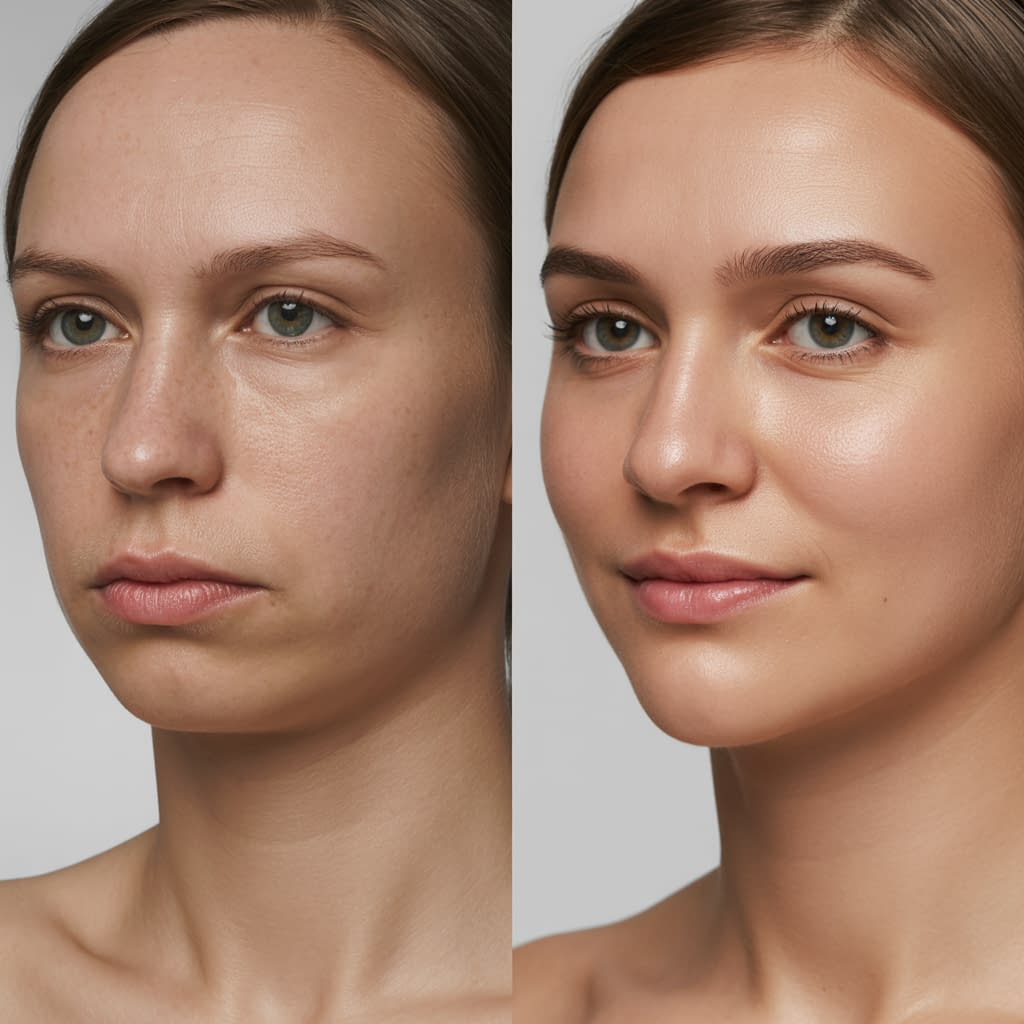
Know when DIY has run its course. Professionals offer treatments that seriously speed and deepen results.
See a dermatologist if:
- You’ve tried a consistent topical + sun protection routine for 3–6 months with minimal improvement and want a faster, bigger change.
- Your sagging is moderate to severe (deep jowls, significant neck bands), or you suspect structural changes like bone loss.
- You’re considering procedures — you need an exam and run through customized options.
Professional options (what they do)
- Injectable fillers: restore volume to cheeks/jawline to reduce the appearance of sagging. Results immediate, durability months to over a year depending on product.
- Botulinum toxin: can be used strategically for lifting (e.g., lower face balancing) and to relax downward-pulling muscles.
- RF microneedling / radiofrequency (Thermage, monopolar RF): stimulate collagen by heat; good for tightening over months with minimal downtime.
- Ultrasound (Ultherapy): targets deep tissue to encourage collagen remodeling; suitable for mild–moderate sagging.
- Laser resurfacing / fractional lasers: tighten skin and improve texture by controlled injury and healing.
- Surgical lift (mini lift/full face lift, neck lift): the only option for large, long-standing sagging if you want a dramatic, lasting change.
How to pick a provider
- Choose board-certified dermatologists or plastic surgeons with experience in facial rejuvenation.
- Ask for before/after photos of patients with similar concerns and skin tone.
- Discuss risks (scarring, downtime, pigment changes especially in darker skin types) and get a realistic plan.
Final Words
If you want tighter face and neck skin without surgery, here’s your condensed plan — do these every day for months:
- Protect: sunscreen every morning (and reapply outdoors).
- Support topically: vitamin C AM, retinoid/peptides PM, hyaluronic acid + a ceramide moisturizer.
- Massage & exercise: 5 minutes daily of targeted massage; neck exercises twice daily.
- Lifestyle: stop smoking, sleep better, reduce sugar, hydrate, and fix your posture.
- Nutrition: prioritize protein, vitamin C, omega-3s, zinc, and antioxidants.
- Be patient: expect meaningful changes after 8–12 weeks and best results after several months. If you need more, consult a dermatologist about non-surgical energy devices or fillers — they bridge the gap between creams and surgery.


